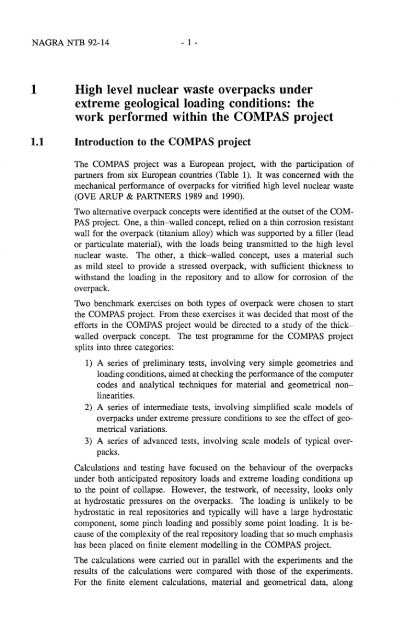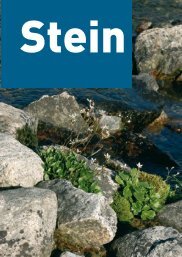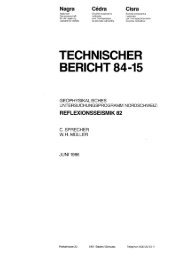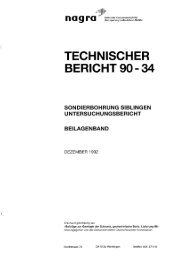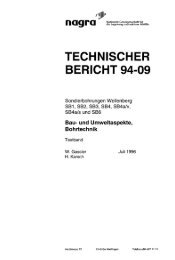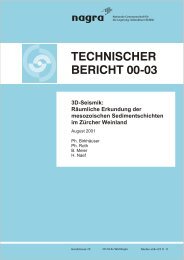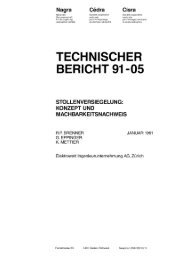TECHNICAL REPORT 92-14 - Nagra
TECHNICAL REPORT 92-14 - Nagra
TECHNICAL REPORT 92-14 - Nagra
Create successful ePaper yourself
Turn your PDF publications into a flip-book with our unique Google optimized e-Paper software.
NAGRA NTB <strong>92</strong>-<strong>14</strong> - 1 -<br />
1 High level nuclear waste overpacks under<br />
extreme geological loading conditions: the<br />
work performed within the COMPAS project<br />
1.1 Introduction to the COMPAS project<br />
The COMPAS project was a European project, with the participation of<br />
partners from six European countries (Table 1). It was concerned with the<br />
mechanical performance of overpacks for vitrified high level nuclear waste<br />
(OVE ARUP & PARTNERS 1989 and 1990).<br />
Two alternative overpack concepts were identified at the outset of the COM<br />
PAS project. One, a thin-walled concept, relied on a thin corrosion resistant<br />
wall for the overpack (titanium alloy) which was supported by a filler (lead<br />
or particulate material), with the loads being transmitted to the high level<br />
nuclear waste. The other, a thick-walled concept, uses a material such<br />
as mild steel to provide a stressed overpack, with sufficient thickness to<br />
withstand the loading in the repository and to allow for corrosion of the<br />
overpack.<br />
Two benchmark exercises on both types of overpack were chosen to start<br />
the COMPAS project. From these exercises it was decided that most of the<br />
efforts in the COMPAS project would be directed to a study of the thickwalled<br />
overpack concept. The test programme for the COMPAS project<br />
splits into three categories:<br />
1) A series of preliminary tests, involving very simple geometries and<br />
loading conditions, aimed at checking the performance of the computer<br />
codes and analytical techniques for material and geometrical nonlinearities.<br />
2) A series of intermediate tests, involving simplified scale models of<br />
overpacks under extreme pressure conditions to see the effect of geometrical<br />
variations.<br />
3) A series of advanced tests, involving scale models of typical overpacks.<br />
Calculations and testing have focused on the behaviour of the overpacks<br />
under both anticipated repository loads and extreme loading conditions up<br />
to the point of collapse. However, the testwork, of necessity, looks only<br />
at hydrostatic pressures on the overpacks. The loading is unlikely to be<br />
hydrostatic in real repositories and typically will have a large hydrostatic<br />
component, some pinch loading and possibly some point loading. It is because<br />
of the complexity of the real repository loading that so much emphasis<br />
has been placed on finite element modelling in the COMPAS project.<br />
The calculations were carried out in parallel with the experiments and the<br />
results of the calculations were compared with those of the experiments.<br />
For the finite element calculations, material and geometrical data, along


